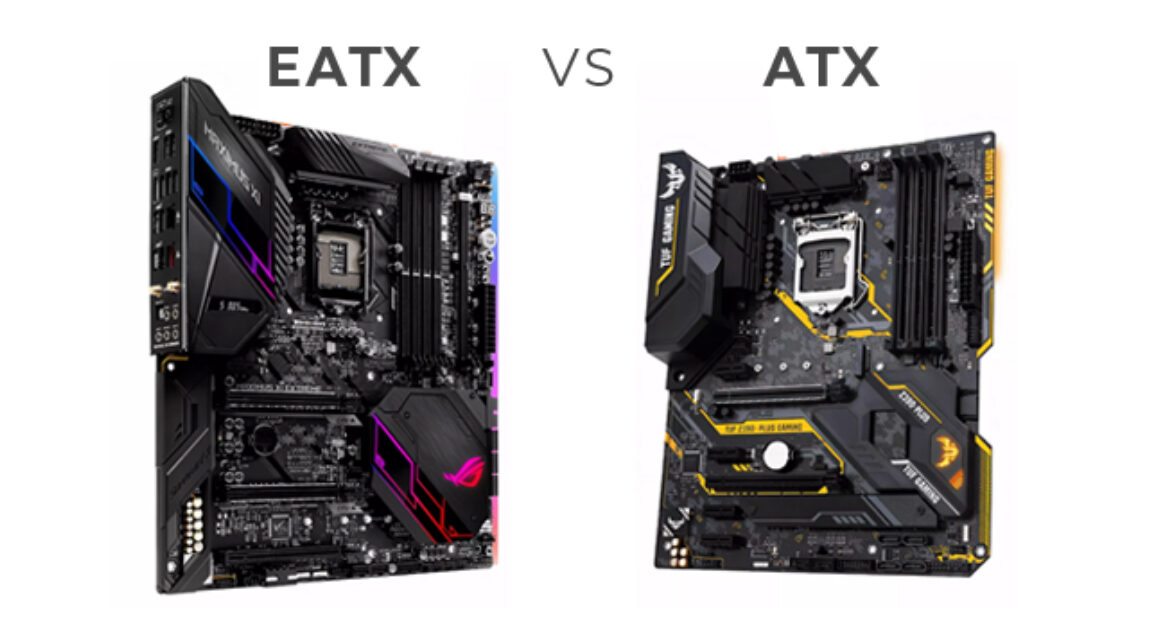In computer hardware, selecting the appropriate form factor for your PC components is crucial for optimal performance and compatibility. Among the various form factors available, two prominent standards, EATX (Extended ATX) and ATX (Advanced Technology eXtended), stand out. Understanding the disparities between EATX and ATX can significantly influence your PC-building experience. Let’s delve into the specifics of each form factor and explore which one suits your needs best.
Introduction to Form Factors in Computers
Form factors in computing refer to the standardized specifications regarding the physical dimensions, layout, and arrangement of components within electronic devices, particularly in PCs. These standards ensure interoperability between different hardware components and facilitate efficient assembly and compatibility.
Understanding ATX Form Factor
ATX, short for Advanced Technology eXtended, is a widely adopted form factor for motherboards, initially introduced by Intel in the 1990s. It sets the standard for the layout and size of components such as the motherboard, power supply, and expansion cards. ATX motherboards typically measure around 12 × 9.6 inches (305 × 244 mm) and feature a standardized layout for connectors and expansion slots.
Introduction to EATX Form Factor
EATX, or Extended ATX, builds upon the foundation laid by the ATX standard, offering additional space and features for high-performance computing. EATX motherboards are larger than their ATX counterparts, providing more room for additional components and expansion slots. They are designed to accommodate demanding tasks such as content creation, gaming, and server applications.
Size and Dimension Comparison
One of the most apparent distinctions between EATX and ATX is their size and dimensions. EATX motherboards are notably larger than ATX motherboards, typically measuring around 12 × 13 inches (305 × 330 mm) or larger. This increased size allows for more expansion slots and connectors, making EATX suitable for enthusiasts and professionals requiring extensive hardware configurations.
Compatibility and Expansion Slots
While both EATX and ATX motherboards offer multiple expansion slots for connecting additional components such as graphics cards, storage drives, and networking cards, EATX boards tend to have more slots available. This abundance of expansion options makes EATX ideal for users who demand extensive customization and connectivity options.
Power and Cooling Requirements
Due to their larger size and increased number of components, EATX systems typically consume more power and generate more heat compared to ATX setups. As a result, adequate power supply and efficient cooling solutions are essential for maintaining system stability and longevity. EATX systems may require higher wattage power supplies and more robust cooling solutions to ensure optimal performance.
Cost Considerations
The cost difference between EATX and ATX components can vary depending on factors such as brand, features, and specifications. Generally, EATX motherboards and cases tend to be more expensive than their ATX counterparts due to their larger size and additional features. However, the long-term cost implications should also be considered, as investing in a higher-end EATX setup may offer greater performance and expandability over time.
Performance and Overclocking Potential
In terms of performance, both EATX and ATX systems can deliver excellent results depending on the specific components used. However, EATX systems may have a slight edge due to their larger size and potential for more robust cooling solutions. This advantage can be particularly beneficial for users engaging in overclocking, as EATX setups may offer better thermal management and stability under heavy loads.
Use Cases and Target Audience
EATX systems are well-suited for enthusiasts, gamers, content creators, and professionals who require extensive hardware configurations and maximum performance. On the other hand, ATX systems cater to a broader audience, including mainstream users, casual gamers, and small businesses seeking a balance between performance and affordability.
Future Trends and Developments
As technology continues to advance, we can expect both EATX and ATX form factors to evolve accordingly. Future developments may focus on optimizing power efficiency, enhancing connectivity options, and improving thermal management to meet the growing demands of users. Additionally, innovations in form factor design and materials may lead to more compact yet powerful solutions in the years to come.
User Preferences and Recommendations
When choosing between EATX and ATX form factors, consider factors such as your specific requirements, budget, and future upgrade potential. If you prioritize expandability, performance, and customization, EATX may be the ideal choice. However, if you value affordability and mainstream compatibility, ATX offers a more balanced option.
Case Studies and Real-World Examples
Numerous case studies and real-world examples demonstrate the versatility and effectiveness of both EATX and ATX setups. From high-end gaming rigs to professional workstation builds, enthusiasts and professionals alike have successfully leveraged these form factors to create powerful and reliable systems tailored to their needs.
Industry Impact and Market Share
The impact of EATX and ATX on the computer hardware market is significant, with both form factors commanding a considerable share of the market. While ATX remains the more widely adopted standard due to its mainstream appeal and affordability, EATX continues to gain traction among enthusiasts and professionals seeking maximum performance and expandability.
Community Discussions and Forums
Online communities and forums are valuable platforms for discussing and sharing insights on EATX vs ATX and other related topics. Engaging in discussions with fellow enthusiasts and professionals can provide valuable perspectives and recommendations to help you make informed decisions when building your PC.
Conclusion
In conclusion, the choice between EATX and ATX form factors ultimately depends on your specific needs, preferences, and budget. Both standards offer unique advantages and capabilities, allowing you to build a PC tailored to your requirements. Whether you prioritize expandability, performance, or affordability, carefully evaluate your options to ensure you select the right form factor for your next PC build.
FAQs
- Which form factor is better for gaming, EATX, or ATX?
- Both EATX and ATX can deliver excellent gaming performance, but EATX may offer more expansion options for enthusiasts seeking maximum customization.
- Are EATX motherboards compatible with ATX cases?
- EATX motherboards are larger than ATX motherboards and may not fit in all ATX cases. Be sure to check the case specifications for compatibility before purchasing.
- Do EATX systems consume more power than ATX systems?
- Generally, EATX systems may consume slightly more power due to their larger size and increased number of components. However, the difference in power consumption may vary depending on specific configurations.
- Can I overclock my CPU with an ATX motherboard?
- Yes, most ATX motherboards support overclocking features, allowing you to push your CPU beyond its stock performance limits. However, the extent of overclocking potential may vary between different motherboard models.
- What factors should I consider when choosing between EATX and ATX?
- Factors to consider include your specific requirements, budget, intended use cases, compatibility with existing components, and future upgrade potential.








